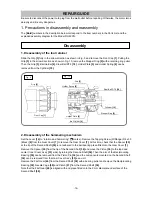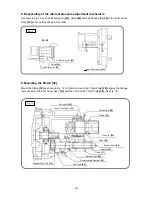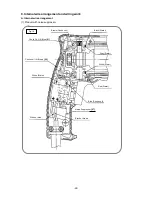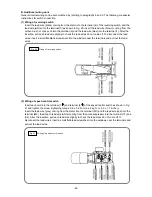
-10-
Fig. 2
Rod
Air chamber
First gear
Piston pin
O-ring
Armature
Tool shaft
Slip mechanism
Second shaft
Motor shaft
Piston
Strike
Second hammer
Second gear
Cylinder
Ring groove
Reciprocating bearing
Second pinion
Cylinder flange
Second shaft spline
Clutch
1. Lubrication
Replenish the grease lubricant when the tool is disassembled or there is grease leakage due to a defective
seal. Changing grease is required once a year to extend the service life of the tool. Special grease is used
in the striking section. Should the striking section (within the gear cover) be disassembled, remove the old
grease from all parts completely and, on reassembly, replenish 30 g of new grease in the gear cover and 10
g in the groove of the inner cover. Be careful not to exceed the designated amount of grease. Excessive
grease will reduce striking efficiency.
2. Tool structure
Transmission of rotation
See Fig. 2. The rotation of the armature is transmitted to the second shaft via the first gear, and causes
it to rotate. The second shaft pinion mounted on the second shaft engages with the second gear
mounted on the outer circumference of the cylinder. The cylinder is coupled to the second gear by
means of a slip mechanism, and they rotate together. The end of the cylinder also functions as the drill
bit retainer. The cylinder is key-connected to the inserted drill bit by means of two key rails and a steel
ball, and transmits rotation to the drill bit.
Piston reciprocating mechanism
In the Model DH 22PG, through adoption of a spiral drive system (a mechanism using a reciprocating
bearing), a more compact design has been achieved by arranging the motor shaft in parallel with the
tool shaft. Figure 2 shows that the drill bit is pressed against the workpiece and the tool shaft is
retracted. The rotation of the armature is transmitted to the second shaft via the first gear. The second
shaft rotation is further transmitted through a spline to the clutch. The cylinder flange is pressed against
the clutch by the retracted tool shaft and the clutch engages with the reciprocating bearing to transmit
rotation to the reciprocating bearing. However, ring grooves on the inner race of the reciprocating
bearing are positioned on an angle of inclination with relation to the second shaft.
The rotation of the inner race and the shaft causes that angle of inclination to change regularly forward
and backward with relation to the second shaft, and produces a rocking motion to the outer race of the
reciprocating bearing. Finally, a rod extending from the outer race of the reciprocating bearing is
connected to the piston by the piston pin, and causes the reciprocating bearing motion of the piston.
REFERENCE MATERIALS
Fig. 2
Rod
Air chamber
First gear
Piston pin
O-ring
Armature
Tool shaft
Slip mechanism
Second shaft
Motor shaft
Piston
Strike
Second hammer
Second gear
Cylinder
Ringed ditch
Reciprocating bearing
Second pinion
Cylinder flange
Second shaft spline
Clutch





































